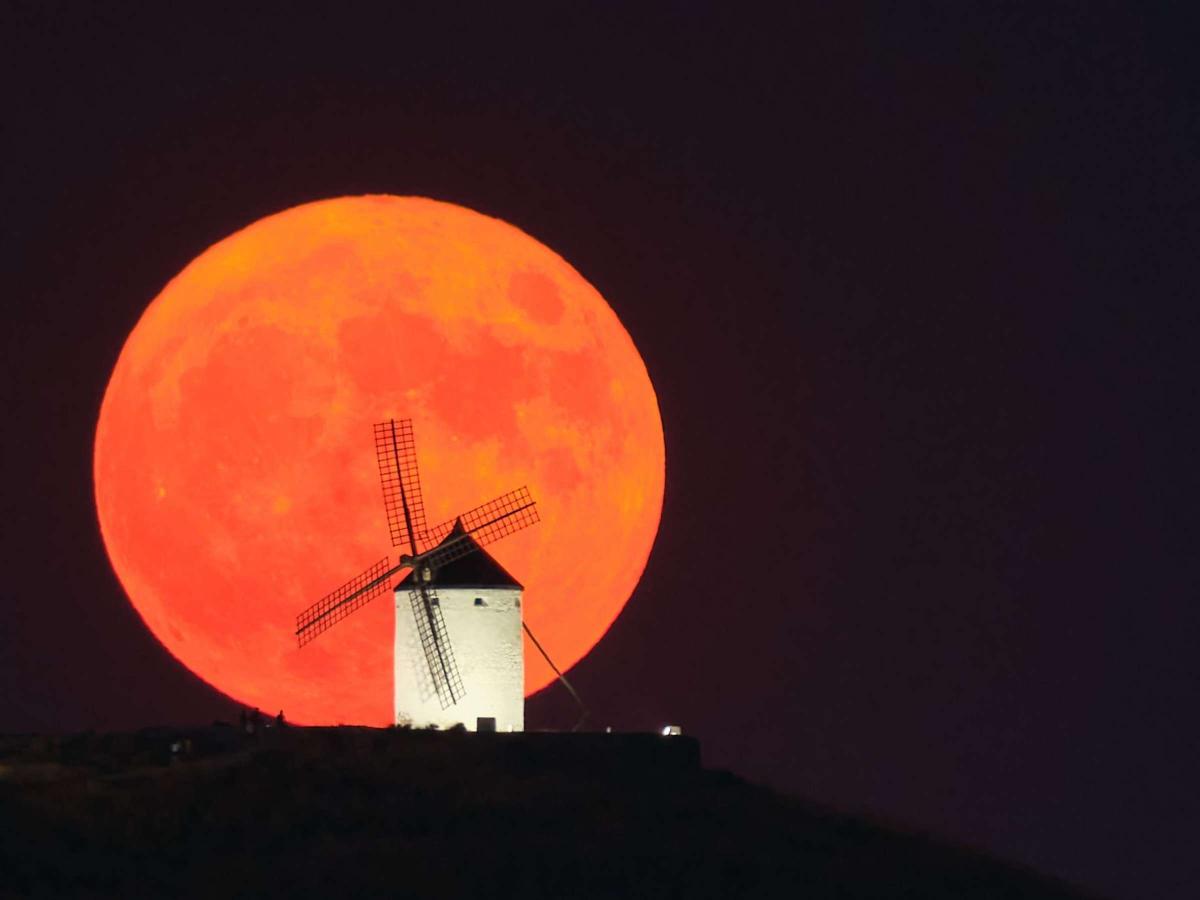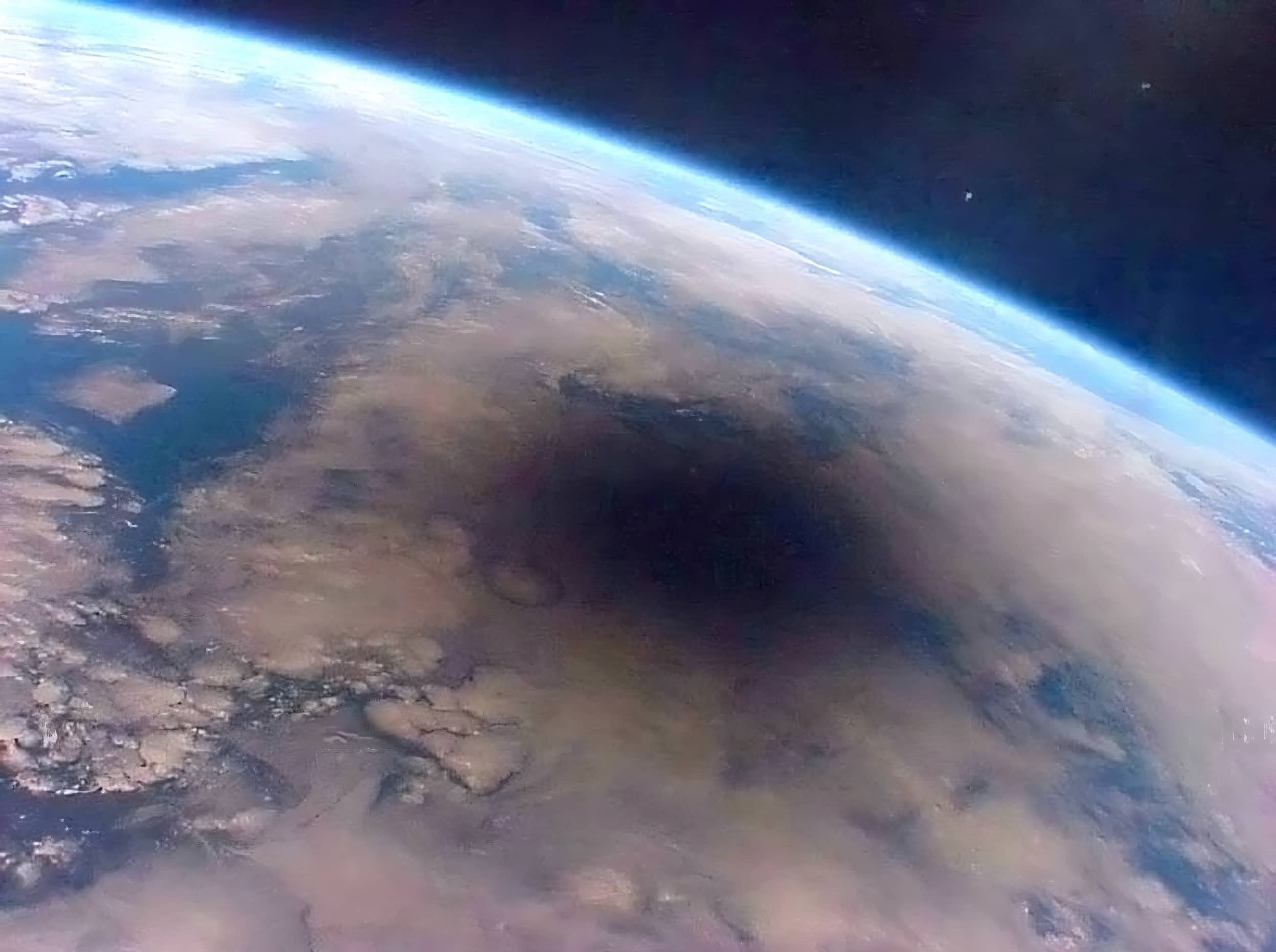Titan is the only moon in the solar system with a dense atmosphere—and the only one with lakes, clouds, and even Earth-like material cycles. But does that mean there is life on Saturn’s moon? Titan was considered an early candidate for extraterrestrial life. However, anyone who wants to exist here must be able to tolerate extremes. Temperatures on the moon are far below zero, and the role of water under these conditions is played by the hydrocarbon methane. Nevertheless, the distant moon has turned out to be astonishingly Earth-like, especially in recent years: It has mountains and volcanoes, lakes and seas, and even tropical storms that race across its surface. Whether life exists on Titan, however, remains an open question.
Titan at a glance
- Discovery: March 25, 1655, by Dutch scientist Christiaan Huygens.
- Distance from Earth: More than 1.2 billion kilometers (km).
- Mean distance from Saturn: 1,221,850 km
- Orbital period around Saturn: Just under 16 days
- Mean diameter: 5,150 km
- Radius: 2,575 km
- Mass: 35 x 1023 kg
- Atmosphere: 94 percent nitrogen, 6 percent methane, and argon, traces of other organic compounds
- Wind speeds: 430 kilometers per hour at 120 kilometers altitude, a few meters per second on the ground
- The temperature on the surface: -178 °C
- Atmospheric pressure on the surface: 1,5 bar
- Highest mountain range: Mithrim Montes, about 10,950 feet (3,340 meters high).
NASA’s Dragonfly Mission
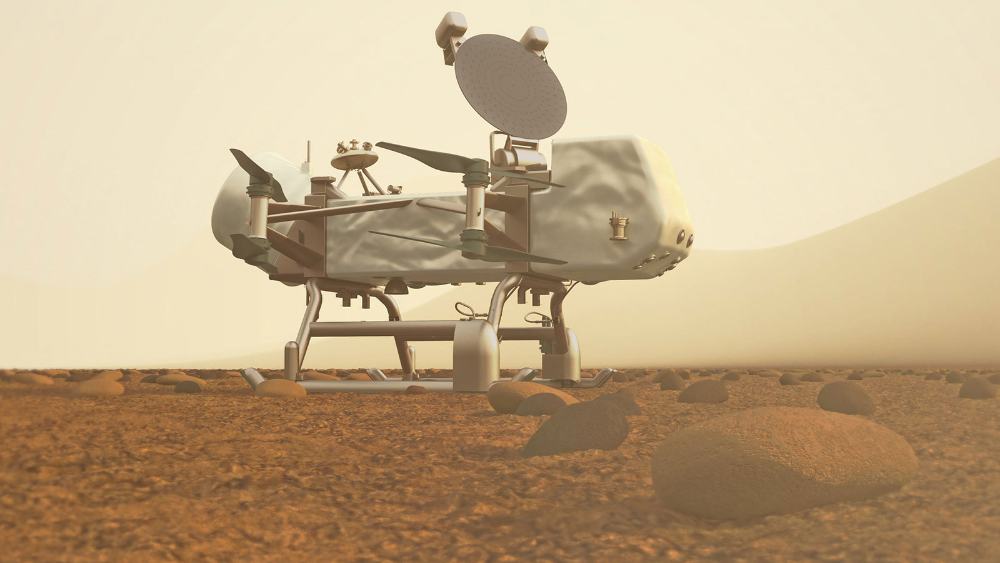
Launching in June of 2027 is the Dragonfly mission, created and managed by the Johns Hopkins Applied Physics Laboratory. As New Frontiers 4, it comprises of a big RTG-powered drone designed to travel through Titan’s atmosphere. Its tools will investigate how far prebiotic chemistry may have come. The target date for the mission’s arrival to Titan is 2034.
Titan raises many questions
Hyperion, Iapetos, Phoebe, Rhea, Tethys, Atlas, Prometheus, and Titan: These are not only all gods from the lineage of the Titans in Greek mythology, but they are also the names of some of Saturn’s moons. One of these many satellites has fascinated scientists ever since its discovery by Dutch astronomer and naturalist Christiaan Huygens on March 25, 1665: Titan.
Opaque atmosphere
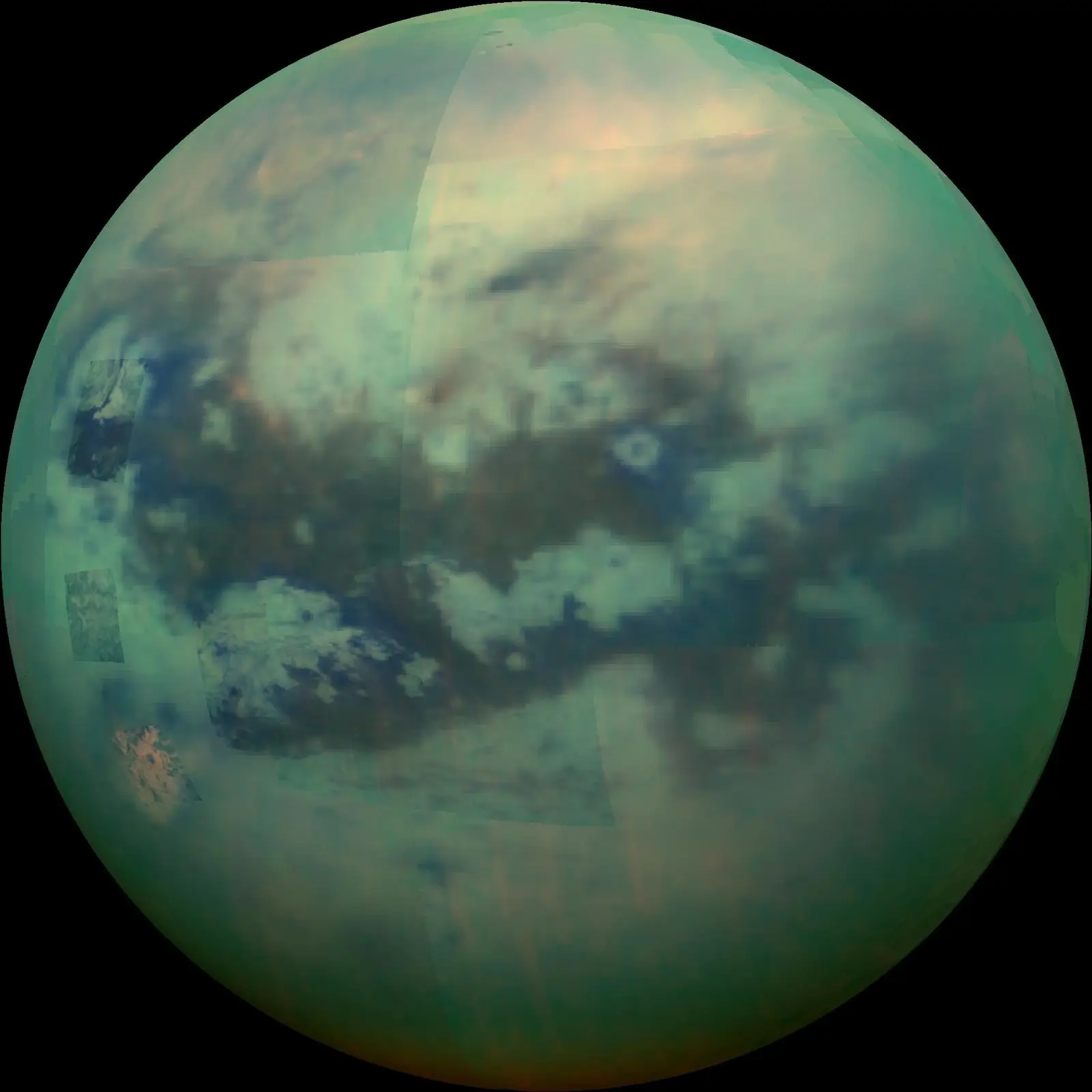
What makes it so special is not only its enormous dimensions—with a diameter of 5,150 kilometers, it is even larger than the planet Mercury. It is also the only moon in our solar system with a dense atmosphere. Like a gigantic, orange-colored veil, it envelops Titan and protects it from intrusive glances of any kind. Titan’s atmosphere is impenetrable not only to the human eye but also to most telescopes on Earth and in space.
Even the Voyager 1 and Voyager 2 probes, which visited the “Lord of the Rings” for the first time about 25 years ago, were unable to dispel the myth of mystery. They did deliver the first meaningful images of Saturn and its moons, and they also carried out numerous measurements. However, even they were unable to get a look at Titan’s surface. Voyager 1 and 2, however, at least clarified the composition of its atmosphere.
Striking resemblance to primordial Earth
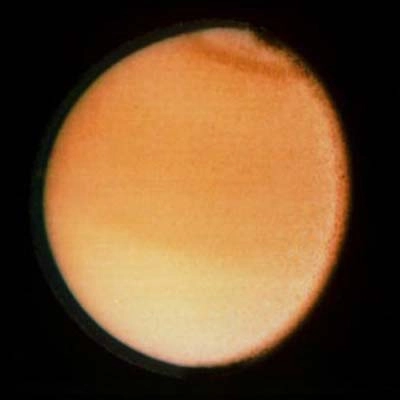
According to the results, the gas envelope consists of about 94 percent nitrogen and about 6 percent methane and argon, as well as about a dozen other organic compounds. This makes Titan’s atmosphere strikingly similar to the shell of the primordial Earth more than four billion years ago, when the first primitive organisms were formed here. However, the air pressure on Titan is half that on the primordial Earth. Ten times as much gas weighs on every centimeter of the ground surface as on ours, and the gas envelope is five times denser near the ground.
But what does the surface of Titan look like? Are there huge methane oceans there, as scientists suspected, or is it a solid ice world? Does Titan, despite its icy cold of -178 °C, offer conditions as favorable for the emergence of life as our planet did in its early days? These are just some of the questions that planetary scientists asked themselves.
Landing on the moon of Saturn
The first glimpses under Titan’s veils were provided by the Cassini-Huygens mission sent to Saturn in 1997 by NASA, ESA, and the Italian space agency ASI. The goal of the two probes, the orbiter Cassini and the piggybacking Titan lander Huygens, was to gather new information about the ringed planet and moons like Titan. The scientists also hoped to find an answer to the question of the origin of the solar system.
On July 1, 2004, the time had come: Cassini and Huygens reached the ringed planet and its moons. The landing of Huygens on Titan was an adventure not only for the many astronomy freaks worldwide, but also for the scientists involved in the mission. What made it a real challenge was not so much the fact that it was the first time a spacecraft was to touch down on a celestial body in the outer solar system.
Residual risk during landing
The maneuver became a risk primarily because the descent and landing had to be completely automatic. Earth is well over a billion kilometers away from Titan. Radio signals to control the probe would therefore have taken more than an hour to cover this distance. For this reason, the course of the action was precisely calculated in advance and meticulously planned—including a residual risk that could not be calculated.
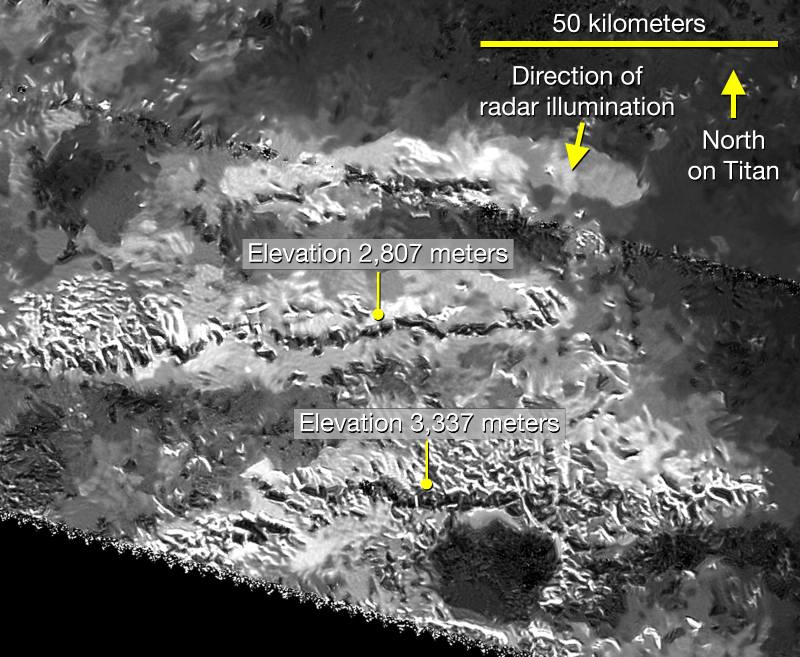
To the great relief of the scientists, however, everything went like clockwork: From separation from the Cassini spacecraft on December 25, 2004, Huygens’ entry into the atmosphere, the two-hour descent and waking of the instruments on board, to impact on Titan at 1:45 p.m. Central European Time (CET) on January 14, 2005.
However, deafening cheers erupted at ESA’s control center in Darmstadt as early as 11:25 a.m: The Green Bank telescope in the U.S. state of West Virginia had received the first clear radio signal from the probe—Huygens was alive. And the probe was already diligently collecting data on the structure of the atmosphere during its descent, recording sounds, and, above all, taking the first images of Titan’s surface.
Images of a strange world
But that was not enough. What the scientists had hardly dared to hope for also happened: Huygens survived the landing on Titan apparently completely unscathed and continued to send data to Cassini for well over an hour. There, the data was saved several times and then forwarded to Earth, just like the measurement results and images recorded by the mother ship itself. Around 500 megabytes in the form of images, measurement results and other data arrived on Earth within the next few hours.
The scientists immediately began sifting through and analyzing the material, and after just a few days, they had their first impression of the distant moon in the outer solar system. The images they finally presented to the public showed a strange world that, despite everything, bears a remarkable resemblance to Earth. “In fact, Titan looks more like Earth than any other celestial body in the solar system – despite the vast differences in temperature and other environmental conditions,” explains Rosaly Lopes of NASA’s Jet Propulsion Laboratory (JPL) in Pasadena.
There are towering mountains, dunes, lakes, and canyons deeply carved by erosion on Titan. As on Earth, erosion over time has leveled most meteorite craters and caused them to nearly disappear. Gullies and river-like formations lead from a higher elevation area to a lower, flat terrain, where they end in depressions. These are bordered by a kind of coastline and are dotted with islands and sandbanks.
Lakes and oceans – from methane
Long before the Cassini mission, planetary researchers had speculated whether there might be liquid methane on Titan. This hydrocarbon is also found as a gas in the atmosphere. It could therefore have risen by evaporation from liquid reservoirs (lakes or even seas) in a similar way to water vapor on Earth.
But when the lander Huygens touched down near the equator of Titan in January 2004, the data were initially disappointing: no trace of liquid hydrocarbons. The early images of the Cassini probe also showed extensive depressions with shore-like boundaries. But these were dry, liquid methane was not found in them.
In 2016, Cassini discovered a network of deep, steep-sided canyons draining into Ligeia Mare, marking the first evidence of fluid-filled passageways on Titan.
The first lakes outside the Earth
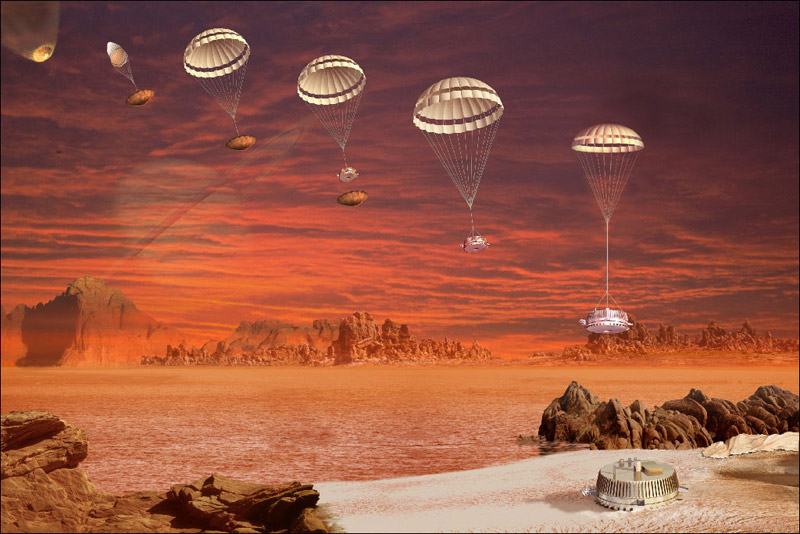
On July 22, 2006, however, the turning point came: Cassini sent new radar images to Earth that clearly showed numerous well-defined, very dark areas in Titan’s north polar region. In the radar image, however, these areas appear extremely smooth—like the surface of a stagnant liquid, for example. “This is a big deal,” comments NASA researcher Steve Wall. “We’ve now discovered for the first time a place outside Earth where lakes exist.”
Nearly a hundred such lakes of varying sizes are now known to exist. Some are completely filled with liquid, while others appear to be half-dry or even empty. Most of them are concentrated near Titan’s north pole. This is also the location of the largest lake known so far, Kraken Mare. This liquid hydrocarbon-filled sinkhole is probably as large as the Caspian Sea on Earth.
“Titan’s northern lake landscape is one of the most Earth-like and fascinating in the entire solar system,” states NASA planetary scientist Linda Spilker. It is possible that these lakes of methane even change with the seasons. Because photographs from Cassini had shown bright areas around some of these lakes, they could arise, for example, from the evaporation of methane and the deposition of residues from larger chemical molecules. In addition, the reflectivity of the lakes varies unusually: Sometimes they appear dark and smooth, then brighter again.
Gas bubbles make methane ice float
Jason Hofgartner from Cornell University in Ithaca and his colleagues proposed an explanation for this in early 2013. Using a model, they show that ice on the surface of the lakes could be responsible for the differences in albedo. Normally, solid methane is denser than liquid methane and would therefore sink. But under certain conditions, even this hydrocarbon ice can float if it contains gas bubbles that lower its density.
This happens when the temperature is just below the freezing point for methane, at 90.4 degrees Kelvin. Then small bubbles of nitrogen become trapped in the forming methane ice. They make up only about five percent of the ice mass, but that is enough to make the ice float. If, on the other hand, temperatures drop just a few degrees lower, too few bubbles form, and the ice sinks. “We now know that there may well be thin ice floes on the Titan lakes, similar to the new sea ice in the Arctic at the beginning of winter,” Hofgartner explains.
The researchers suspect that these ice floes made of hydrocarbons are similarly transparent to water ice. But because of the reddish-brown atmosphere and thus also slightly colored gas bubbles, they could also have a slightly reddish tint. And another aspect could make the ice on the Titan lakes exciting: On Earth, many organisms live in the channels and margins of sea ice. Therefore, the boundary layer between ice and liquid hydrocarbon could also provide a habitat for possible life on Titan.
A turbulent atmosphere characterizes Titan’s surface
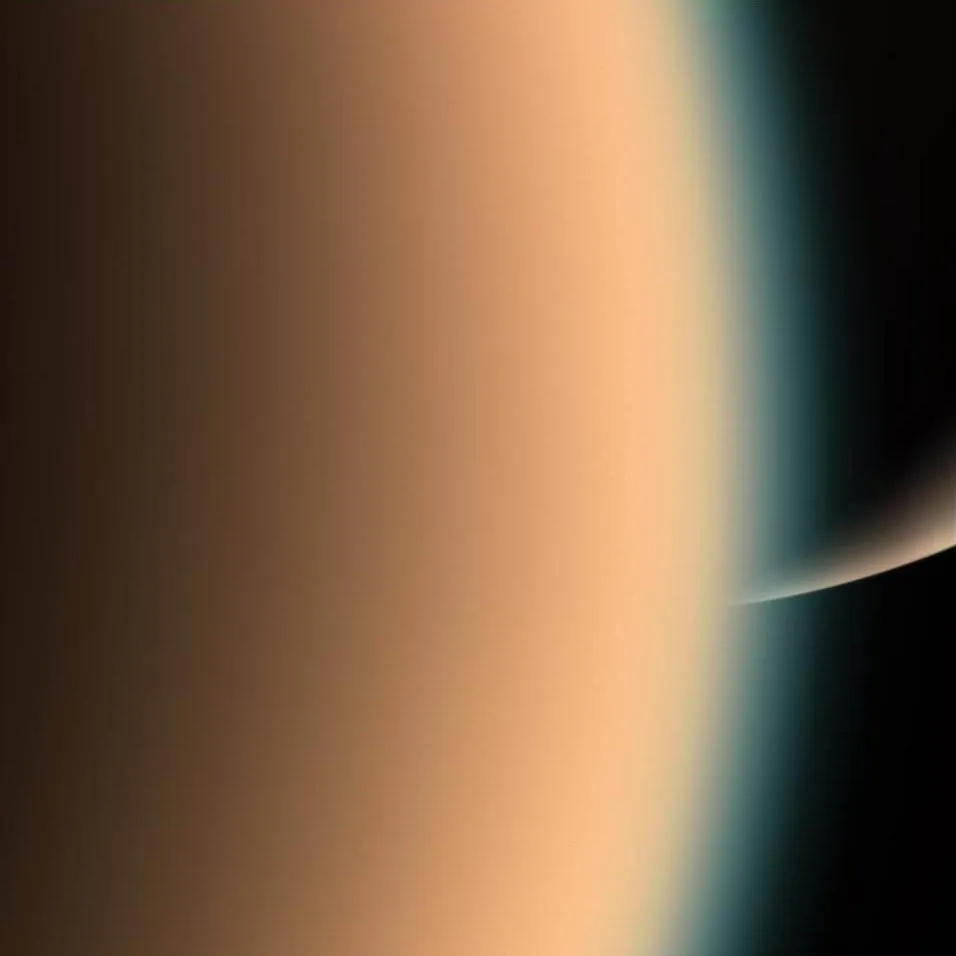
It has lakes and seas, an atmosphere, and also ice. If water were involved in all these phenomena, Titan would not only be extremely Earth-like, but it would also provide important conditions for life. But: On Titan, the defining element is not water, but a hydrocarbon, methane. The clouds in the moon’s ice-cold, dense atmosphere therefore also consist not of water droplets, but of methane. Initial measurements by the Cassini spacecraft already showed that Titan’s atmosphere consists of two layers of very thin, barely visible veil clouds separated by a distinct gap.
Eternal rain
The upper layer consisted of ice clouds, while the lower layer contained methane and nitrogen in liquid form. The hydrocarbon rains down from there onto Titan’s surface. “The rain on Titan is just a light drizzle, but it rains all the time. “Day in and day out,” explains Christopher MacKay of NASA Ames Research Center. To be sure, the amount of rain on Titan is not excessive at five centimeters per year; it’s about the same as what falls in Death Valley in the United States. “The difference is that the rain on Titan falls evenly distributed throughout the year.” The liquid methane makes the ground wet and muddy.
And even storms can occur on Titan, as was shown in April 2008. Researchers at NASA’s Infrared Telescope Facility (IRTF) on Mauna Kea in Hawaii registered a telltale increase in the thermal radiation Titan was emitting at the time. Astronomers quickly turned to their colleagues at the neighboring Gemini North Telescope, an eight-meter dish, and asked them to take high-resolution snapshots of Titan. The unique feature of this telescope is a special adaptive optics system that compensates for atmospheric disturbances, allowing it to achieve resolutions comparable to those of space-based telescopes.
Sure enough, the high-resolution infrared images revealed a massive storm that covered more than three million square kilometers of Titan’s atmosphere—roughly the area of the entire Indian subcontinent. Since Titan is less than half the size of Earth, this was not only the largest storm detected on it, but also the first to lie over the tropics of the Moon.
Methane cycle replenishes lakes
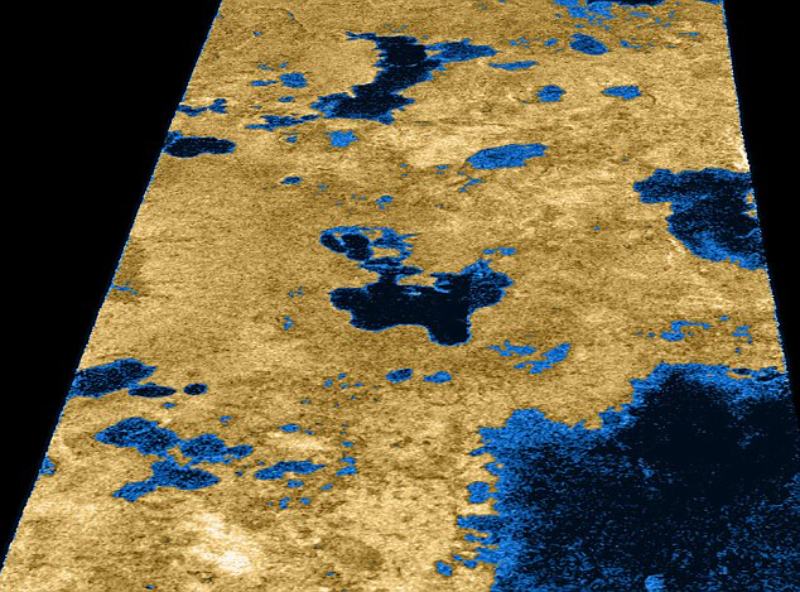
Astronomers believe storms like this one could well explain why deep canyons and valleys exist even at the Moon’s equator, as they typically do from the erosion of large bodies of water. Heavy methane rain from such storm clouds probably causes rip tides of liquid methane to race through the valleys for a short time. For several weeks, the researchers estimate, such a storm can affect the entire weather patterns of Titan.
The discovery of these phenomena made it clear that also on Titan the surface and the atmosphere form part of a large cycle—the methane cycle. Liquid methane continuously evaporates from the lakes and seas and also from temporarily filled canyons and valleys. The rising gas in turn ensures that the methane content in Titan’s atmosphere remains stable. At the same time, some of this methane gas falls to the surface as rain, which in turn replenishes the lakes there.
How were Titan’s mountain ranges formed?
As early as 2005, radar images from the Cassini spacecraft revealed that the highest mountain peaks on Titan rise some 10,950 feet (3,340 m) into the air. Titan’s Himalayas, a massif in the moon’s southern hemisphere, are after all about 150 kilometers long, 30 kilometers wide and more than 1,500 meters high. The peaks and higher elevations are covered with a sugary coating of shiny white material that is probably methane snow.
Rock-hard mountains of ice
These massive mountain ranges remind us of the Sierra Nevada. These mountains are probably as hard as stone, but they are made of an ice-like material and are covered by various layers of organic compounds. At the time, Brown and his colleagues initially suspected that these mountains might have formed in much the same way as mid-ocean ridges on Earth—through plate tectonics.
According to this theory, large amounts of material—probably water, methane, and ammonia—rose from Titan’s warmer interior through convection currents and then filled the gaps created when crustal plates moved apart. There they cooled down and piled up with time to today’s visible mountain range. The heat necessary for the convection currents could have come from the decay of radioactive minerals or from so-called tidal forces from the parent planet, the scientists say.
Mountain ranges by shrinking crust
In the meantime, however, something speaks against this scenario. So far, the Cassini data have provided no evidence for tectonic processes. Mapping of Titan has also shown that most of the mountain chains near the equator run in an east-west direction; for planetary researchers, this is a possible indication of the common origin of these chains.
In 2010, a team of NASA researchers used the probe data to develop a computer model that they used to recreate possible geologic processes on Titan. Based on the known geological and physical conditions on Titan, the researchers modified their model until they succeeded in growing mountain chains similar to the existing ones. It turned out that Titan’s Himalayas and other mountain formations were most likely to form when the model called for the shrinking and contracting of the moon’s ice crust.
A liquid ocean beneath Titan’s crust
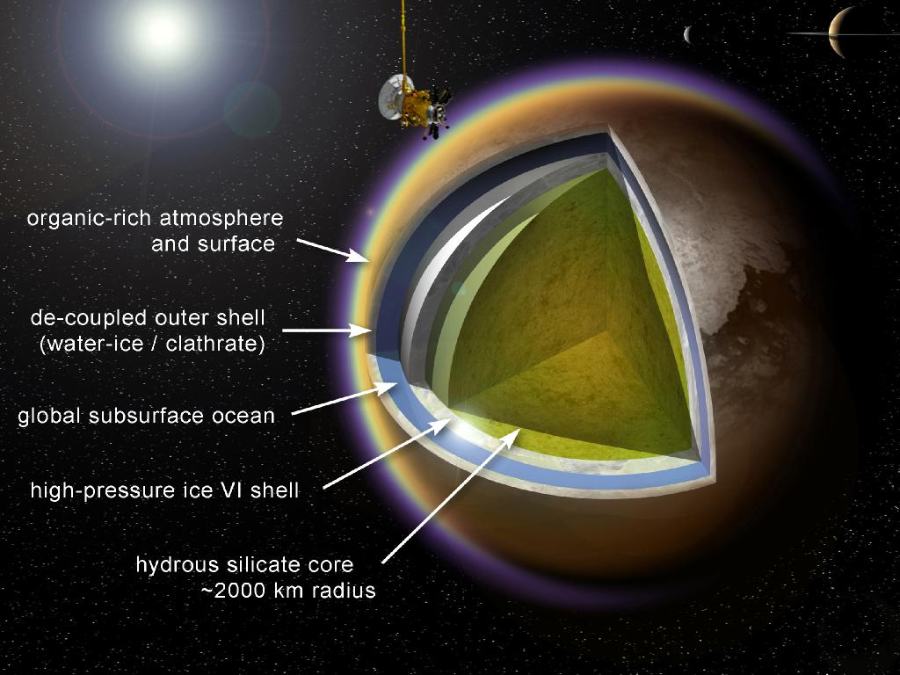
But this scenario has a catch: the moon’s crust can only shrink so much if there is a liquid layer beneath it—an ocean. In fact, researchers had already discovered circumstantial evidence for the existence of such an ocean of ammonia and water with the help of Cassini data in 2008. For their study, they compared the positions of 50 conspicuous landmarks in images from the probe’s first and most recent surveys.
Moving mountains and lakes
The results showed that the mountains, lakes, and canyons were no longer in the same place. Up to 25 kilometers of offset resulted from the data comparisons. According to Ralph Lorenz of Johns Hopkins University in Baltimore and his colleagues, such a systematic shift can only be explained if one assumes a decoupling of the crust from the core of the celestial body—for example, by a huge ocean beneath the crust.
In their model of building mountains, NASA researchers assumed that the inner core of the moon is surrounded by a very dense layer of high-density water ice. This is followed by a liquid layer of a water-ammonium mixture—the ocean. Above this lies the crust of ice, which is about 80 kilometers thick. Because Titan has been gradually cooling since its formation about four billion years ago, all the layers are contracting slightly. This ultimately causes the entire moon to shrink very slightly; scientists estimate that Titan has lost about seven kilometers in radius and about one percent of its volume since its formation.
This shrinking compresses the outer ice crust and causes faults to form, which, among other things, lifted the mountain ranges out of the landscape like shrinkage seams. A similar mechanism—shrinkage and collapse of a limited area of Earth’s solid rock crust—is responsible on our planet for the formation of the Zagros Mountains in Iran.
Unusually tilted axis of rotation
Further evidence of a liquid ocean beneath Titan’s crust was provided in 2011 by another study based on Cassini data. Gravity and radar measurements reveal that Titan’s rotation and orbit are very similar to those of our Earth’s moon, but with one important difference: the rotation axis of Titan is tilted by 0.3 degrees, which, according to the researchers, is unusual for such celestial bodies.
Such a tilted axis usually occurs when there is at least one liquid layer inside the object. When the researchers fed a model with different variants of an internal structure of Titan, the variant with an ocean under the crust gave the best agreement with the moon’s rotation and inertia data. But even that was only a theoretical model, not real evidence.
Tides provide missing evidence
NASA researchers then came closer to this in 2012 with another observation: the moon, which orbits Saturn once every 16 days, has pronounced tides. Its surface rises and falls by 30 meters depending on its orbital position, Cassini’s measurements revealed. “The tides on Titan are not huge compared to those on some of Jupiter’s moons,” says Sami Asmar of NASA’s Jet Propulsion Laboratory. “But these data tell us quite a bit about Titan’s possible internal structure.” That’s because if Titan were solid throughout, its surface should only fluctuate by about three meters. But it does so ten times more. But this leads scientists to the almost inevitable conclusion that Titan must have an ocean beneath its crust.
How deep this ocean lies and how thick the liquid layer is is something planetary researchers can only speculate about. However, to cause the observed tidal effects, a relatively narrow layer between the outer, deformable ice crust and the solid mantle would be sufficient. And such an ocean could also explain another phenomenon Cassini revealed on Titan: ice volcanoes.
Titan’s volcanoes with lava made of ice

There are towering mountain peaks and entire mountain ranges on Titan. But are there also fire mountains on it—volcanoes that transport material from the interior to the surface? As long as Titan lay hidden under its dense veil, this question was unanswered. But the first images taken by the Cassini spacecraft in 2005 already showed the first signs of volcanism. At that time, researchers identified a 30-kilometer snail shell structure near Titan’s equator that rose several hundred meters above the surrounding area like a dome.
Frozen water instead of hot magma
Scientists have not seen anything similar on any other icy moon in the solar system. The preferred interpretation is that methane is leaking out of this mountain from underground onto the surface and escaping into Titan’s atmosphere. Scientists refer to this phenomenon as “ice volcanism” because it involves frozen water or methane rather than hot magma being transported upward.
New infrared images from a Cassini flyby on Oct. 25, 2006, appeared to confirm this type of volcanism on Titan, showing a fan-shaped structure that strongly resembled lava flows. The Cassini radar had already photographed this phenomenon and a circular structure on the surface from which this flow appears to emanate during an earlier flyby, but not in such good quality.
“The likelihood is increasing that this ring-shaped structure is indeed a volcano,” explained Rosaly Lopes of the Cassini radar team at NASA’s Jet Propulsion Laboratory. “Just from the radar data, we identified it as a possible volcano, but the combination of radar and infrared makes it much more definite.”
Do volcanoes light up or darken the surface?
Then in 2008, another flyover by the probe revealed telltale changes in brightness and reflectivity in two specific regions of Titan. “The Cassini data suggest that Titan’s surface may be active,” said Jonathan Lunine of the University of Arizona’s Lunar and Planetary Laboratory in Tucson. “This is based on evidence of changes that have occurred on Titan’s surface between Cassini flybys. In some regions, the radar images indicate some kind of volcanism.”
In one of the two regions, the albedo rose steeply and remained higher than expected. In the second, it also rose, but then dropped again. Albedo is the ability of a surface to reflect solar radiation. The higher the albedo, the more reflective the surface.
Cassini also detected frozen ammonia in both areas. “Ammonia is thought to be present only beneath Titan’s surface,” explains Robert M. Nelson of NASA’s Jet Propulsion Laboratory. “The fact that we’ve detected it at times where the surface has brightened the most suggests that material from within Titan has been transported to its surface.” The existence of methane-spewing volcanoes would also explain why Titan atmosphere hasn’t dissipated long ago.
Ground fog or mudflows
Other researchers, however, interpreted these data much differently at the time: they argued that the identification of the ammonia was not certain and that the changes in brightness could also be due to ground fog from ethane droplets – and thus to atmospheric rather than geophysical processes. Nelson, however, thought this rather unlikely. “There remains the possibility that this effect is caused by local fog, but if it were, we would expect it to change in magnitude over time due to wind. That’s not what we’re seeing, though.”
Researchers at NASA Ames Research Center postulated another alternative: “Similar to Jupiter’s moon Callisto, Titan may have formed as a relatively cold body and thus never received enough tidal heat to allow volcanism,” speculated NASA planetary geologist Jeffrey Moore. “The river-like structures we see on the surface could also be ice debris that was liquefied by methane rains and then transported downhill like mudflows.”
Final proof of cryovolcanoes
The final proof of active cryovolcanism on Titan that continues to this day was then provided in September 2013 by researchers led by Anezina Solomonidou of the Observatoire de Paris. For their study, they analyzed data collected by the Cassini spacecraft’s Visual and Infrared Mapping Spectrometer (VIMS) from three potentially ice-covered volcanic regions: Tui Regio, Hotei Regio, and Sotra Patera. “Thanks to the VIMS, we were able to penetrate Titan’s atmosphere and observe changes in the surface over time,” Solomonidou explains. And in the process, they noticed telltale changes. “Interestingly, the albedo actually changed over time for two of the three areas,” the researcher reports.
If there is active cryovolcanism on Titan, freshly spewed water or methane should freeze and then become visible as bright deposits on the darker, older surface. Elsewhere, freshly rupturing vents could perhaps also be seen briefly as darker patches. As the researchers report, Tui Regio actually grew darker from 2005 to 2009, and Sotra Patera—the top candidate for ice volcanoes on Titan—brightened significantly from 2005 to 2006.
This would fit with previous observations that landscapes strongly resembling terrestrial volcanoes, calderas, and lava flows exist, especially in these areas. According to the scientists, these observations, together with the new data, suggest that Saturn’s largest moon may have ice volcanoes associated with the liquid water reservoir beneath its crust. “These results also have great significance for Titan’s potential to sustain life,” Solomonidou states. “This is because the cryovolcanic regions could provide environmental conditions in which life could arise.”



